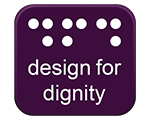Guidance on customer service
Mobility
People with physical disability may be restricted or limited in the way they move around or communicate. Some people with physical disability may use a wheelchair to get around, others may use crutches or a walking stick, while others may have restricted upper body or arm movements, or may be without any obvious signs.
Wheelchair Users
People who use wheelchairs to get around need level access.
Stairs, narrow or crowded aisles, or uneven footpaths can make it very difficult for wheelchair users to move around safely.
In addition, thick carpet or rugs, computer or telephone cables, and even protruding table and chair legs can create barriers and hazards to wheelchair users.
Customers who use wheelchairs or other mobility aids have the same rights as all other customers and should be made to feel welcome in every situation.
Ways you can help
- Offer a stable surface such as a clipboard for the customer to write on if a counter is out of reach.
- Make sure that EFTPOS machines and other systems are cordless or are on a cord long enough to pass to someone in a wheelchair.
- You may have to come out from behind a counter in order to help a customer unload their shopping basket items onto the counter, or to hand the customer an EFTPOS machine or clipboard to sign.
- For detailed transactions, try and put yourself at eye level with the customer and speak directly to them.
- Ask the customer if they would like any assistance before assuming. For example, offer to carry bulky items or open heavy doors.
- When passing something to a customer, if they can't take hold of it, ask them how they can best take receipt of it. For example, the customer may suggest you hang the shopping bag on the back of their wheelchair.
- For people who experience fatigue, or people standing in queues, consider offering them a chair.
- Make sure you know where the accessible bathrooms are and ensure that they are free from unnecessary items. Know the most accessible route into and out of the premises.
Avoid:
- Touching or moving the customer's wheelchair unless asked to do so by the customer.
- Standing behind a wheelchair user.
- Patronising or talking down to a wheelchair user.
Be aware that:
- Customers in a wheelchair may hang bags or other things on their wheelchair. Their wheelchair is a part of their individual personal space and should be respected.
- Customers who use crutches or other mobility aids may require extra assistance when carrying things, or getting up and down stairs. Offer to help but always remember to ask before helping any customer.
- It is important to make sure crutches and walking sticks are safely out of the way, but never move a customer's belongings without their knowledge and consent.



